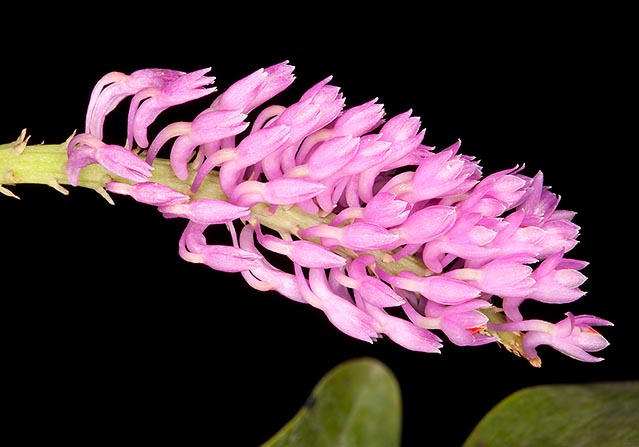Family : Orchidaceae

Text © Pietro Puccio

English translation by Mario Beltramini

The Dendrobium secundum semi-closed tiny flowers look all to the same direction © Giuseppe Mazza
The name of the genus is the combination of the Greek terms “déndron” = tree and “bios” = life, with reference to the numerous species of the genus living on the trees; the name of the species is the Latin adjective “secundus” = second, following, with reference to the flowers all turned in the same direction.
Common names: tooth-brush orchid (English).
The Dendrobium secundum (Blume) Lindl. (1829) is an epiphytic species with pseudobulbs up to about 80 cm of length and 1,8 cm of diameter, erect or partially drooping, cylindrical, thinned at the base as well as at the apex, grooved when ripe, carrying alternate oblong, opposite, leaves which may be up to 10 cm long and 4 cm broad.
Racemose inflorescences, usually single, from the nodes close to the apex of the ripe and leafless pseudobulbs, 7-15 cm long, carrying several flowers, 40-60, all pointing towards the same direction, 1,6 cm long and 0,6 cm broad, waxy, of colour going from the pale pink to the purple, rarely white, with orange labellum at the apex, which remain semi-closed.
The sepals are ovate with pointed apex, the two lateral, merged together at the base of the column, form a sort of spur as long as the sepals, the petals are similar, but smaller and the labellum is ovate; the flowers last 2-3 weeks and are slightly scented.
It reproduces by seed, in vitro, by micropropagation and by division, with each section provided with 3-4 pseudobulbs.
Little cultivated species at amateur level, it requires, during the vegetative period, high temperatures, humidity and luminosity, with regular waterings, but leaving the compost to dry up, if in pot, before giving water again, upon growth completion, to observe a dry period in winter, with slightly cooler temperatures, in order to have the flowering till the coming of the new vegetation; a constant, good, ventilation is fundamental.
For the waterings and the nebulisations is to be used rain water, or obtained by reverse osmosis, or demineralised; the fertilizations, duly distributed in way to avoid salts accumulation, are to be done during the vegetative period, preferably with hydrosoluble balanced products, with microelements, at ¼ of the dosage suggested on the package.
Due to the partially drooping posture and in order to allow the roots to quickly dry up between the watering it is preferably to be mounted on bark, trunks, cork or arborescent ferns roots rafts, if cultivated in pot, a small one is to be chosen, with much draining and aerated compost, which may be formed by medium sliced bark fragments, with addition of perlite and charcoal fragments.
The species is reported into the appendix II of CITES (species whose trade is internationally ruled).
Synonims: Pedilonum secundum Blume (1825); Dendrobium bursigerum Lindl. (1859); Dendrobium heterostigma Rchb.f. (1859); Callista bursigera (Lindl.) Kuntze (1891); Callista secunda (Blume) Kuntze (1891); Pedilonum bursigerum (Lindl.) Rauschert (1983).
→ For general notions about ORCHIDACEAE please click here.
